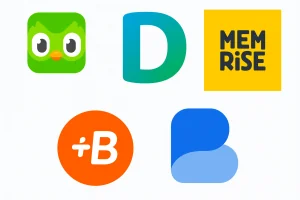With February 14th and St Valentine’s Day upon us once again, love is in the air and on the minds of many people.
Learning a language and nurturing a romantic relationship share many similarities – both often start with initial flames of passion and desire, ultimately leading to a deeper, more complex appreciation and understanding of each other. They both also require time, effort, emotional connection, and active participation. So read on, as we explore some of the connections between love and language.
It takes time
Both learning a language and maintaining a relationship require a significant investment of time. Of course, how long it takes to learn a language depends on many factors, but researchers estimate that it can take between 100 – 150 hours to get from A1 to A2, and 180 to 260 hours to get from B1 to B2. The results of a 2022 study found that, on average, it can take between 69 and 120 days for couples to first confess their love for each other. The takeaway message here is that one can’t expect immediate results, and that rather than rushing towards love and fluency, one should instead enjoy the journey and process.
Put in the effort
As with most things in life: the more one puts in, the more they will get out. The same is of course true with love and language. Both learning a language and a romantic relationship require active participation and engagement to be successful. Whether it’s using your target language or spending quality time with a partner, active participation will lead you to a deeper understanding. Consistency and dedication are key to success in both, which leads us on to the next connection…
Stick with it
Commitment is a scary word for some, but developing a skill and nurturing a relationship do require dedication and commitment. In terms of language learning, you need to understand that it won’t be easy and that you are going to make mistakes. But as with relationships, you shouldn’t necessarily abandon your efforts at the first sign of difficulty, instead, take a moment to think about what you’re doing, why you’re doing it, and how you might be able to do it better.
Build an emotional connection
Both require an emotional connection, whether it’s a connection to the language or a connection to another person. This spark helps fuel motivation and increase engagement. This could be something like wanting to read your favorite book in its original language, being able to order a croissant in the French cafe you’ve been dreaming about, or even learning the language of your ancestors to build a deeper connection to your past. Tap into that emotional connection and let it lead the way.
Find out how you’re doing
Feedback is important to help you understand what you are doing well and which areas need more attention. In language learning, it is often more structured and tangible, with assessments, quizzes, and exercises to measure your progress. Relationship ‘feedback’, on the other hand, is often more informal and subtle, and depends on both verbal and nonverbal communication. In both cases, it will help you know where you stand and see where you’re going.
Happily ever after? There’s an app for that
Both learning a language and starting a romantic relationship require a combination of time, effort, commitment, emotional connection, and active participation to be successful. Though DuoCards is not (currently!) able to play Cupid, it can make the process of learning a language more engaging and fun, setting you up for a solid relationship with your target language.
DuoCards allows for active participation through interactive and engaging exercises that keep users motivated and focused on their language learning goals. You can choose to study content from the app’s library of flashcards, articles, and videos, or add your own content. Timely notifications will remind you of your commitments to language learning and the progress you’re making, helping you to stick to your learning goals. These features mean that you are able to follow your heart’s desire and, in doing so, make it easier to fall in love with the language you’re learning.





